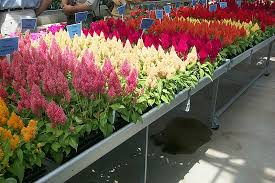Growing flowers, whether at home or commercially, is both rewarding and enjoyable. Flowers bring color, fragrance, and life to any space, making them an essential part of any garden or landscape. Flower cultivation can be done for personal satisfaction or as a profitable business, with many different varieties to choose from. This guide will walk you through the basics of flower growing, from selecting the right varieties to understanding how to care for your flowers so they thrive.
Benefits of Growing Flowers at Home and Commercially
Flower growing offers a range of benefits, both on a personal level and in a commercial setting. Whether you’re looking to beautify your garden or create a flower business, here are the key advantages:
1. Beautification of Spaces
Flowers bring color and beauty to homes, gardens, and public spaces. Growing flowers at home enhances the appearance of your yard and gives you access to fresh, fragrant blooms. For commercial growers, flowers are in demand for events like weddings and holidays, making them a valuable product for beautifying various settings.
2. Health Benefits
Being around flowers can improve mental well-being. Studies have shown that flowers can reduce stress, enhance mood, and promote relaxation. Gardening itself is a physical activity that keeps you active and can boost overall health. Commercially, the flower industry also creates employment, offering opportunities in cultivation, sales, and floristry.
3. Environmental Impact
Flowers play a key role in supporting pollinators like bees and butterflies, which are essential for healthy ecosystems. Growing flowers can improve biodiversity and promote sustainable practices. Commercial flower farming, when done responsibly, can also contribute to ecological balance by preserving native species.
4. Economic Benefits
Commercial flower growing is a profitable business. The global demand for fresh and ornamental flowers is high, creating income opportunities for growers, retailers, and florists. Additionally, selling flowers at local markets, craft fairs, or through floristry businesses can bring in steady revenue.
Selecting the Right Flower Varieties

Choosing the right flowers to grow depends on factors like climate, soil conditions, and personal preferences. Here’s how to select the best varieties for your needs:
1. Consider Your Climate
Different flowers thrive in different climates. Some, like sunflowers, love full sun and heat, while others, such as pansies, prefer cooler temperatures. Look for flowers suited to your region’s temperature, rainfall, and seasons.
2. Bloom Time
Select flowers that bloom at different times of the year to ensure a continuous display. For example, daffodils and tulips bloom in spring, while chrysanthemums and marigolds are perfect for fall. A mix of flowers that bloom at various times keeps your garden colorful year-round.
3. Purpose and Design
If you’re growing flowers commercially, consider the demand for specific varieties. Roses, lilies, and orchids are often in high demand for bouquets and special occasions. If growing at home, think about the color scheme and design of your garden, choosing flowers that complement each other in size, shape, and hue.
4. Native vs. Exotic Varieties
Native flowers are more likely to thrive with less effort since they are adapted to your local environment. Exotic flowers may require more care and maintenance but can add unique and striking elements to your garden.
Preparing the Soil for Flower Cultivation
Healthy soil is crucial for flower growth. Before planting, take the time to prepare the soil to provide your flowers with the best environment possible.
1. Test the Soil
Start by testing your soil’s pH level and nutrient content. Most flowers prefer slightly acidic to neutral soil with a pH of 6.0 to 7.0. You can buy a simple soil test kit at garden centers or send a sample to a lab for more detailed analysis.
2. Improve Soil Structure
If the soil is too compact or sandy, your flowers will struggle to grow. Loosen compacted soil by turning it with a shovel or tiller. If your soil is heavy with clay, add organic matter like compost to improve drainage and aeration. Sandy soil can be enriched with compost or manure to retain moisture and nutrients.
3. Add Nutrients
Enrich your soil with organic materials like compost, manure, or leaf mold. These will improve fertility and help retain moisture. You can also add slow-release fertilizers that will provide essential nutrients over time.
4. Remove Weeds and Debris
Clear the planting area of any weeds, rocks, or debris. Weeds can compete with your flowers for nutrients and water, so it’s important to eliminate them before planting.
Read Also: Recommended Volume of Water for Fish Farming on a Concrete Pond
Choosing the Ideal Location and Climate

Selecting the right location for your flowers is key to ensuring they grow well. Here are important factors to consider:
1. Sunlight Requirements
Most flowers need plenty of sunlight, usually around 6 to 8 hours per day. Choose a spot in your garden that receives ample direct sunlight. For shade-loving flowers like begonias and ferns, find a location with partial or full shade.
2. Shelter from the Wind
Flowers with delicate stems or large blooms, like dahlias or lilies, can be damaged by strong winds. Plant these flowers in areas that are sheltered from strong winds, such as near a fence or building.
3. Soil Drainage
Avoid planting flowers in areas where water tends to collect, as this can lead to root rot. Choose a location with well-draining soil to prevent water from sitting at the roots.
4. Climate and Temperature
Consider your local climate when selecting flower varieties and planting times. In cooler climates, plant cold-hardy flowers, and in warm climates, choose heat-tolerant varieties.
Planting Techniques for Flowers
Proper planting techniques are essential to give your flowers the best start. Here’s a step-by-step guide:
1. Prepare the Planting Holes
For seedlings or bulbs, dig planting holes according to the recommended depth. Bulbs, for example, should be planted about two to three times their height deep in the soil. Seedlings should have a hole large enough to cover the root ball.
2. Space Your Plants
Spacing is important to prevent overcrowding. Check the instructions for each flower variety to determine the correct spacing. Overcrowded flowers compete for sunlight, water, and nutrients, leading to stunted growth.
3. Water After Planting
Water your flowers immediately after planting to help settle the soil around the roots. Make sure to water deeply but avoid overwatering, as this can lead to root rot.
4. Mulch the Area
After planting, add a layer of mulch around your flowers to retain moisture, keep the soil temperature stable, and prevent weeds from growing. Organic mulches like bark or straw work well.
Watering and Irrigation Methods
Watering is crucial for flower growth, but it’s important to do it right to avoid water stress or root diseases.
1. Watering Frequency
How often you water depends on the type of flower and the climate. In general, water when the top inch of soil feels dry to the touch. During hot weather, you may need to water more frequently, while cooler weather requires less frequent watering.
2. Watering Depth
Deep watering encourages deep root growth, making flowers more resilient to drought. Water at the base of the plants, allowing the water to soak deep into the soil. Avoid overhead watering, as wet leaves can encourage fungal diseases.
3. Irrigation Systems
For larger flower gardens or commercial flower farms, consider installing drip irrigation or soaker hoses. These systems deliver water directly to the soil, reducing evaporation and ensuring efficient water use.
Fertilization and Soil Nutrition for Flower Health
To keep your flowers healthy and blooming, proper fertilization is essential. Here’s how to ensure your flowers get the nutrition they need:
1. Understand Nutrient Needs
Flowers need three primary nutrients: nitrogen (N), phosphorus (P), and potassium (K). Nitrogen promotes leafy growth, phosphorus supports root and bloom development, and potassium strengthens the overall plant health.
2. Use the Right Fertilizer
Choose a balanced fertilizer (like a 10-10-10 mix) for general flower growing. For flowering plants, a fertilizer high in phosphorus (such as 5-10-5) can promote more blooms. You can use organic fertilizers like compost or bone meal for a natural approach.
3. Apply Fertilizer at the Right Time
Fertilize your flowers at key growth stages. Start with an application at planting time, then continue feeding every 4-6 weeks during the growing season. Be careful not to over-fertilize, as this can lead to excessive leaf growth and fewer flowers.
4. Monitor Soil Health
Periodically test your soil to ensure it remains rich in nutrients. If necessary, adjust your fertilization plan based on the soil’s nutrient levels.
A Comprehensive Guide to Flower Growing and Care: Part 2
Controlling Pests and Diseases in Flower Gardens
Pests and diseases are common challenges for flower growers, but with proper care and attention, you can keep your flowers healthy. Below are effective strategies for pest and disease control:
1. Regular Inspection
Check your flowers regularly for signs of pests like aphids, caterpillars, and spider mites. Look for discoloration, holes in leaves, or wilting plants. Catching problems early makes it easier to control them.
2. Natural Pest Control Methods
Use eco-friendly methods like introducing beneficial insects (e.g., ladybugs, lacewings) that feed on harmful pests. You can also use organic sprays made from neem oil, garlic, or soapy water to keep pests at bay.
3. Preventative Measures
Planting pest-resistant flower varieties and maintaining good garden hygiene (removing dead leaves, trimming overgrown plants) will help prevent infestations. Avoid overwatering and ensure proper spacing between plants to reduce the risk of fungal diseases like powdery mildew or root rot.
4. Proper Fungicide Use
For fungal diseases, use organic or chemical fungicides if necessary. Always follow instructions on the label to avoid damaging your plants.
Read Also: Concrete Pond Management: Steps to take before introducing the Fish in the Water
Pruning and Maintenance for Optimal Growth

Pruning is essential for maintaining healthy flowers and promoting new blooms. Here’s how to keep your plants in top shape:
1. Prune Regularly
Deadhead spent flowers to encourage more blooms and remove any dead or damaged stems. This helps direct the plant’s energy toward healthy growth and keeps the garden tidy.
2. Trim at the Right Time
For most flowering plants, prune in the early spring before new growth starts. Some flowers, like roses, benefit from mid-season pruning after their first bloom to promote a second flowering.
3. Use the Right Tools
Always use sharp, clean pruning shears to avoid damaging the plant. Clean your tools between cuts to prevent the spread of diseases.
4. Maintain Shape
For flowers like hedges or shrubs, regular trimming helps maintain their shape and prevents overgrowth. This is especially important for commercial flower growers who want uniformity in their crops.
Harvesting Flowers: Best Practices
For commercial flower growers or home gardeners looking to display fresh blooms, knowing when and how to harvest flowers is crucial. Here are the key practices:
1. Harvest in the Early Morning
The best time to harvest flowers is in the early morning when they are fully hydrated, and the temperatures are cooler. This helps ensure the blooms stay fresh longer.
2. Cut at the Right Stage
Harvest flowers when they are in the bud stage or just beginning to open. Flowers harvested too late will wilt faster, while those picked too early may not open fully.
3. Use Sharp Tools
Always use sharp, clean scissors or pruners to make smooth cuts. Avoid crushing the stems, as this can prevent the flowers from absorbing water.
4. Immediately Place in Water
After cutting, place the stems in water immediately to prevent dehydration. Use a clean bucket or vase filled with lukewarm water to keep the flowers fresh.
Post-Harvest Care and Storage for Commercial Flower Growers
Proper care after harvest is vital to maintaining the quality of flowers, especially for commercial growers who need their products to last during transport and sale. Follow these steps for optimal post-harvest care:
1. Hydrate Flowers
Immediately place harvested flowers in water with floral preservative to extend their vase life. Keep them in a cool, shaded place for a few hours to help rehydrate and recover from the stress of cutting.
2. Store in Cool Temperatures
Commercial flower growers should use cool storage to extend the life of their blooms. The ideal temperature for flower storage is between 34°F and 36°F (1°C to 2°C). Ensure that the flowers are not exposed to freezing temperatures.
3. Remove Foliage Below Water Line
To prevent bacterial growth in the water, remove any leaves that would be submerged when placing flowers in a vase or storage bucket.
4. Maintain Humidity
Flowers last longer in high humidity. If storing flowers commercially, use a humidifier or place a damp cloth over the flowers to maintain moisture levels.
Common Challenges in Flower Growing and How to Overcome Them
Every grower faces challenges in flower cultivation, but with the right strategies, you can overcome them:
1. Poor Soil Conditions
Solution: Test your soil regularly and amend it with organic matter or fertilizers. Poor soil can be corrected with the right balance of nutrients and proper drainage.
2. Pests and Diseases
Solution: Implement regular pest monitoring, use natural predators, and apply organic pesticides or fungicides as needed.
3. Inconsistent Watering
Solution: Install an irrigation system for even watering. Ensure that the soil is well-draining but retains enough moisture for plant health.
4. Climate Variability
Solution: Select flower varieties suited to your climate. Use greenhouses or row covers in extreme weather conditions to protect your flowers.
Seasonal Care Tips for Different Flower Types
Different flowers require unique care throughout the year. Here are seasonal tips to help your garden thrive:
1. Spring
Plant early-blooming flowers like tulips, daffodils, and pansies. Begin fertilizing after the last frost and prune any dead foliage from the previous year.
2. Summer
Water more frequently as temperatures rise, especially for heat-sensitive flowers like hydrangeas. Deadhead spent blooms to encourage new growth.
3. Fall
Plant late-blooming flowers like chrysanthemums and asters. Start preparing perennial flowers for winter by cutting back dead stems and applying mulch to protect the roots.
4. Winter
For flowers like poinsettias or winter jasmine, provide frost protection with row covers or bring pots indoors. Limit watering to prevent root rot.
Sustainability and Eco-Friendly Practices in Flower Growing
Sustainability is becoming more important in gardening and commercial flower growing. Here’s how you can make your flower growing practices more eco-friendly:
1. Use Organic Fertilizers
Opt for organic compost or natural fertilizers to nourish your flowers without harming the environment. Composting garden waste is a great way to reduce waste while improving soil health.
2. Save Water
Use drip irrigation systems to minimize water waste. Mulching your garden can also help retain moisture, reducing the need for frequent watering.
3. Grow Native Species
Native flowers are more likely to thrive with minimal intervention and support local ecosystems. They require less water, fertilizer, and pest control than exotic species.
4. Avoid Chemical Pesticides
Use natural pest control methods, such as introducing beneficial insects, or apply organic pesticides made from neem or citrus oils. This reduces the harmful impact of chemicals on the environment.
Marketing and Selling Flowers Commercially
For those growing flowers commercially, marketing is key to reaching buyers and generating profit. Here are strategies for success:
1. Identify Your Market
Determine whether you’re selling directly to consumers (e.g., at farmers’ markets or local stores) or supplying to florists, event planners, or wholesale markets. Tailor your marketing and sales efforts accordingly.
2. Build an Online Presence
Use social media platforms like Instagram and Facebook to showcase your flowers. Beautiful photos of your blooms can attract potential customers and help build your brand.
3. Attend Local Markets and Events
Selling at farmers’ markets, craft fairs, or local events allows you to interact directly with customers. Bring a variety of flowers to attract different buyers, and consider offering pre-arranged bouquets for convenience.
4. Offer Delivery or Subscription Services
Consider offering flower delivery or subscription services where customers can receive fresh flowers on a regular basis. This can create a loyal customer base and ensure steady revenue.
Read Also: Adaptive Means of Animals Coping with the Environment
Frequently Asked Questions
We will update this section soon.

